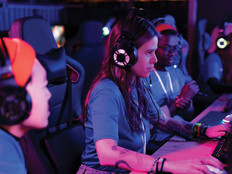Immersive Technology in Schools Is on the Rise
The number of students across the globe who will access virtual reality (VR) and augmented reality (AR) via head-mounted displays will jump from 2.1 million in 2016 to 83 million in 2021, reports Futuresource Consulting.
EdWeek Market Brief indicates new partnerships with educational publishers by Microsoft, Google and Oculus will help drive more usage in the U.S.
A recent survey from Project Tomorrow found that as of this year, only nine percent of students in grades 6 through 8 and eight percent of students in grades 9 through 12 have experience with AR and VR in a class setting.
However, cardboard viewers and cheaper headsets, like offerings from Lenovo, Acer and Samsung, will make it a bit easier for schools to incorporate VR and AR in the classroom.
VR and AR Touch Down to Expand Student Horizons
Some school districts are already making innovative strides with VR, like the Detroit-area Utica Community Schools. District Administration reports that students in four elementary schools have used VR to explore the human body, build rollercoasters to study gravitational pull and design car prototypes. All of the immersive experiences at Utica schools have a purpose outside of the wonder they produce in the students.
“One of the reasons we wanted to introduce virtual reality to our students is because we sit in the heart of the defense and automotive industries,” says Superintendent Christine Johns in the article. “Industry is already using these tools to design the dashboard of a car, for example.”
An article by the Center for Digital Education indicates that, like using gamification to teach complex topics, VR can help engage students on topics that might usually bore them.
With the help of cheaper VR viewers like Google Cardboard, low-income students can take field trips to places they’d never get to see before.
“It provides equity in access,” says Janice Mak, a Phoenix-based instructional coach, in the article. “I’ve taught in Title I places where kids have never traveled outside of Phoenix, even to the Grand Canyon. VR is about bringing the experience to students everywhere at very little cost.”
Prep Your School Infrastructure for VR Now
As VR continues to expand to the classroom, CoSN’s Tony Inglese tells EdTech that it is relatively easy to establish the network support for most of today’s immersive technology.
“Really what you need with Google Cardboard and Google Expeditions are access points that can support 20 to 30 students streaming Netflix,” says Inglese. “Right now, that’s really quite doable.”
Inglese also recommends that districts set up their networks in a modular structure so they can easily expand and add access points as schools add more technology.








